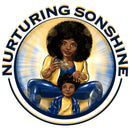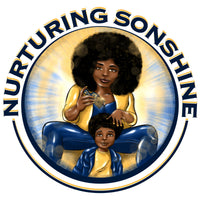Natural Hair Types: How Do You Know?
Decoding your son’s natural hair can be confusing, but it's a necessary step that will allow you to make informed decisions when it comes to what type of products you need. Whether your son has tight coils, dehydrated curls, or an array of textures, you want to understand how to best manage his mane. If you're following the standard hair types 1 through 4 with subcategories of A to C, you can discover his curly type and see which products will work best for both styling and manageability. Especially for little ones who have dense strands or straw-strung coils, understanding your son’s hair is essential to a successful regimen for you both.
Put His Curls to the Test
You may think you know your son’s hair by just looking, but there's a lot more that goes into knowing his strands. Think of the structure of what makes up a hair follicle. There's the cuticle, the cortex, and the medulla. Depending on the status of each layer, you can begin to determine how your son’s hair reacts and what that means in terms of best care solutions.
One simple way to test his hair is by checking the porosity levels. The porosity affects how well the hair absorbs oils and retains moisture. For understanding curly hair types, knowing the hair's porosity is especially important because you want to ensure the products chosen are compatible. Even if it seems like the most incredible product for curls, it's a possibility that your son’s hair won't react the same. While a certain conditioner may be known for quenching dry curls, there's a chance the porosity levels won't match up well for absorption. There are three different porosity levels ranging from low to high.
Low: Cuticles are close together
Medium: Cuticles are less tightly bound
High: Cuticles are widely spaced
Testing for porosity can be done with a quick experiment using just a glass of water. With clean and dried hair, pull a strand of hair into the glass of water and observe how the hair reacts.
Low porosity: Strand remains floating on top of the water
Medium porosity: Strand floats somewhere in the middle
High porosity: Strand quickly sinks to the bottom of the glass
Once you've identified the porosity level, you can feel more confident in the products you choose for your little man. Although there is no perfect guide when it comes to caring for various curly hair types, this discovery gets you one step closer to healthier and more manageable curls. Beyond porosity and the science behind hair, identifying your curl type make a significant impact on how you choose best care practices that will follow your son throughout his life. While there are so many different textures in the curl world, once you know the category his hair best identifies with, he becomes a part of a special curl community.
Identifying Each Curly Hair Type
It's a beautiful sight to see your son’s hair take shape and learn more about different routines and products. But if you can't strongly identify his curly hair type, you may be missing out on opportunities for growth, strength, and styling. Just like finding his personality type, a curl type is an important part of his hair journey and will become a huge deciding factor on product purchases. Out of the 12 types of hair textures, curly hair stays within the type 3 and type 4 categories. Here's a breakdown to see if you fall under these curly classifications.
Type 2:
|
2A: This hair type is the most loose out of all curly hair types. While it may seem easier to manage, this curl type requires careful product selection to avoid weighing the hair down. |
|
2B: With a little more wave than 2a, this curl type also holds onto a lot of product, which can weigh the hair down. This hair is also more prone to frizz. |
|
2C: For this pattern, the waves are more defined with most potential for frizz. This hair type can be introduced to heavier products that previous patterns. |
Type 3
|
3A: Each strand is fine, shiny, and falls with loose compared to deeper curl patterns. This type of curly thick hair is easily defined even without heavy styling products and is prone to slight frizz.
|
|
3B: In this subcategory, the hair has curls that are medium to tight bounce, also known as springy curls. While this curl type is prone to exhibit multiple hair types together, it is also prone to frizz.
|
|
3C: As the tighter pattern in the category, this hair produces a quick bounce with thicker curls. The curls of this hair type normally have a lot of texture with a corkscrew-like spiral.
|
Type 4
|
4A Each coil is typically tight with springy coils with a delicate upward motion from root to tip. Hair strands of this type typically shrink to half their length when dry, creating this rainbow shape. This type of hair has the most definitive curl pattern of the Type 4 hair category. |
|
4B This hair incorporates a sea of Z coil (crimpy) curls. While it is less defined than Type 4A curls, it holds onto oils amazingly compared to other hair types.
|
|
4C As the tightest curl pattern, each strand is densely packed and coarse. The curl pattern of this hair type had more a freeing definition and more shrinkage. |

